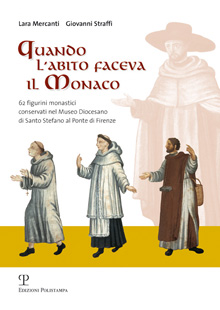
Sessantadue “figurini” di monaci, conservati nel Museo Diocesano di Santo Stefano al Ponte di Firenze, ci conducono nell’affascinante e misterioso mondo degli ordini religiosi. Le normative dei vari Istituti avvertivano (ricordiamo l’antichissimo detto) che l’abito non fa il monaco, ma gli attribuivano anche l’importante compito di specificare chi si era e quale ruolo si ricopriva. In alcuni periodi l’abito assunse un valore che superava la funzione pratica: alcuni ordini lo imponevano anche di notte, altri non permettevano di toglierlo nemmeno durante gravi malattie. Scrive nel 1705 Clemente Pistelli a proposito del fondatore dei chierici regolari minori:
“… non mirò giamai (oltre le mani) parte alcuna del suo corpo ignuda; che perciò dormiva sempre vestito, e bisognandogli talvolta rappezzar le calzette, non le levava dalle gambe, per non lasciarle scoperte, ma sopra di esse le raggiustava al meglio…”.
L’epoca della realizzazione dei sessantadue quadretti è da collocarsi intorno alla prima metà del Settecento. Per consistenza e tema la collezione è una vera rarità e ha spinto gli autori a condurre una meticolosa ricerca durata anni. Oltre all’abito religioso in generale e all’evoluzione del suo significato storico e sociale, sono trattate le origini dello specifico gruppo di figurini, descrivendo per ognuno di essi l’ordine religioso, le vesti, gli accessori e mettendo in luce quanto la moda abbia sempre interessato il mondo religioso, per la sua capacità di esprimere concetti simbolici.
An extraordinary fashion show with monks belonging to different orders and times.
Sixty-two fashion plates, kept at the Diocesan Museum of Santo Stefano al Ponte in Florence, lead us to the fascinating and mysterious world of the religious orders. The rules of the various Orders informed (echoing the old proverb) that it was not the cowl that made the monk, despite its function of defining the person and the role held. In some periods the clothing assumed a value that exceeded its practical function: some orders imposed it also at night, others did not permitted to take it off either during a serious illness. In 1705 Clemente Pistelli wrote, with regard to the founder of the minor monks: “I did not see any part of the body unclothed, besides the hands; they always slept clothed and sometimes they needed to mend their socks”.
The realization of the sixty-two plates has to be placed in the first half of the 18th century. The collection, for its theme and ampleness, is a real rarity, what convinced the authors to carry out an accurate research that lasted many years. Besides the religious clothing in general and the evolution of its historical and social meaning, were studied the origins of this specific group of plates; for each of them were described the religious order, the clothings, the accessories and highlighted how fashion has always interested the religious world, for its ability of expressing symbolic concepts
Polistampa, 2006
Pagine: 240
Caratteristiche: ill. col., cart.
Formato: 17x24
ISBN: 978-88-596-0101-2
Settori: